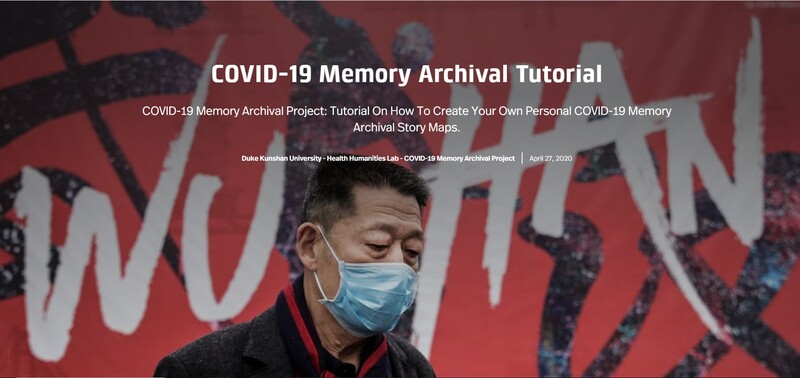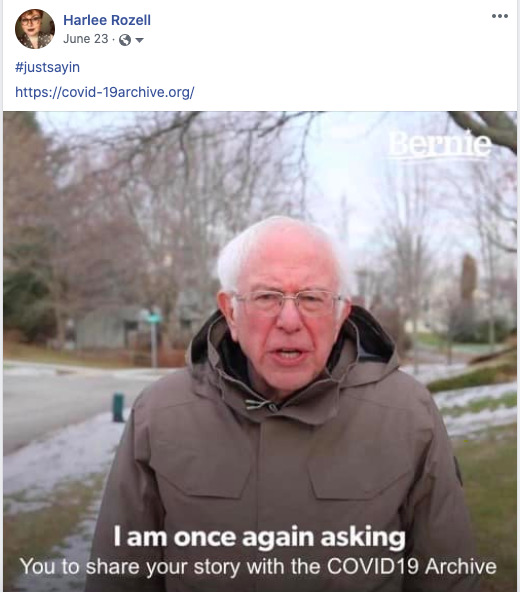Items
topic_interest is exactly
archive
-
 2020-12-04
2020-12-04Northeastern University HIST 1323 Optional Assignment Prompt
This is an optional assignment given to students in Northeastern University HIST 1323, History of Boston, taught by Dr. Rabinovitch in Fall 2020. -
 2021-04-20
2021-04-20JOTPY Exhibit: "Arizona's COVID-19 Pandemics" by James Rayroux
While working as a curatorial intern on ASU's 'A Journal of the Plague Year' COVID-19 archive, I created this exhibit on the pandemic experience within the state. In addition to obvious, overarching realities such as socioeconomic status and immediate access to healthcare systems, I initially believed one of the greatest deciding factors that determined one's experience in Arizona was an individual's residence in either predominantly urban or rural environments. The proposed exhibit had been originally titled "A Tale of Two Arizonas" to pay respect to Charles Dickens and the differing realities experienced here. To test my proposed hypothesis, I went about finding data, stories, and submissions that substantiated or disputed my premise. Within a short time, I had identified four distinct environmental drivers of personal pandemic experiences; to me, that indicated the existence of many more I hadn't yet found or had overlooked along the way. My evidence suggested a minimum of four pandemic locales: Urban, Rural, Border, and Tribal within the State of Arizona and its fifteen counties. The recorded health data and personal experiences demonstrated the naivete of my initial hypothesis, and I retitled the exhibit: "Arizona's COVID-19 Pandemics." The Exhibit Background section illustrates the vast dichotomies within Arizona in terms of population density and access to healthcare facilities. Given the virus's respiratory nature, these factors seemed especially relevant to driving diverse local experiences. I chose to include a flyer from the Coconino County Health and Human Services' "Face It! Masks Save Lives" campaign. The flyer included a specific line to "Stay Home When Sick" that seemed to illustrate a different public health paradigm than the broader "stay home" orders from Maricopa and Pima county. This section also features an image of Sedona's red rocks and a portion of The Wave to remind visitors of the wide-open rural areas accessible to all, as well as those with cultural significance to the Native American tribes and limited access to the general public. The next section asks a short, five-question survey in which visitors may participate. The Silver Linings piece features a short audio clip of a father and husband discussing some unexpected benefits of the pandemic. Visitors may explore additional Silver Linings stories and submit their own experience. The Tséhootsooí Medical Center piece seeks to illustrate the different pandemic experience on the state's tribal lands. I hoped to inspire some relevant emotional turmoil for the visitors through the piece's visual presentation. I wanted to create a series of waves with quotes from the medical center's healthcare workers. I hoped visitors' attention would be drawn to the large, bolded key words, and that they would first experience the segments out of sequence because of that. After potentially feeling a sense of chaos, they might settle themselves into a deliberate reading of the texts and find their own order within the experiences provided here. This piece allows further exploration of Native submissions and topics, a review of an additional related news article, and a submission prompt that invites visitors to offer guidance to hospital managers. The next piece illustrates the differences between mask mandates in communities across Arizona. In addition to hearing an audio clip of interviews with mayors and a public health official, visitors can explore additional submissions related to mask mandates and submit their thoughts on statewide mandates. The Arizona Department of Health Services provides zip-code specific infection data on its website, and the wide array of known case infections therein further illustrates potential dichotomies across the state. In working to include and represent this data in a consumable way, I encountered inconsistencies with tribal data. The nation's Indian tribes are overseen by Indian Health Services, a federal public health agency, and it does not collect or report data in the same manner as the State of Arizona or its counties. At first glance, the data would seem to suggest that tribal areas had less severe pandemic experiences than the rural and urban areas, which was not objectively true. I wanted to offer the unedited data to visitors, allow them to drawn their own conclusions, and invite them to offer their thoughts on what potential misunderstandings might emanate from these reporting differences. Visitors may also choose to review the foundational data from this piece, as well. I used the following two sections to offer submission prompts about the visitor's overall pandemic experience as a function of their location, as well as what they might have done if placed in charge of their city, county, or state during this pandemic. A diverse Search section allows visitors to explore additional topics of interest to them. 23 hyperlinks offer pre-defined search parameters. An Advanced Search link allows self-defined research, and a Join The Staff link connects visitors with opportunities to work within the JOTPY archive. A final section asks visitors to provide feedback on the exhibit, its content, and the pandemic in general. Both surveys within the exhibit will display overall results to visitors who participate in them. Through this process, I found incredible amounts and diversity of data outside the archive that spoke to these generally localized experiences, but not that much yet within the archive explained what Arizonans had experienced outside the state's urban environments. I created a call for submissions and delivered it to fifty rural entities that might help support the effort to collect and preserve more rural Arizona stories. Between all the local libraries, historical societies, museums, small-town mayors, and county health officials to whom I asked for help, I am optimistic the archive will better represent all Arizonans in the coming months and years. Despite the exhibit having been created, I ensured its internal search features would include future submissions and allow the exhibit to remain relevant long after its release. -
 2021-02-11
2021-02-11Oral Histories and Archiving
Looking through the oral history section of JOTPY, I noticed a few recordings of interviews. This got me thinking about oral history and its similarities to journalism and the work journalists do. I then started thinking about how journalists and historical societies could work together to keep oral histories and newspapers. Could there be a way for journalists to get the correct permission from their interviewees to have their recorded interviews be put into the historical society of the area where they’re working? I was thinking of my time at a small-town newspaper in a rural area. What if my interviews with the local people and the local government officials who aren’t necessarily big-names were put into the archive to help fill the space? Could these interviews help provide a bigger picture of the town and the way it worked during this timeframe? Could they fill a “silence” these historical societies and their archives have? I also recorded town hall meetings and school board meetings almost every week. These meetings are recorded, but often in written form by a secretary. I was recording these events via phone/recording device (actual audio). The work I was doing (the work a journalist does) offers another medium for the archive. I think this would be an interesting interdisciplinary project, especially within rural areas. And what about now? The move towards online meetings and discussion due to the pandemic allows more accessibility to these board meetings or interviews. But are they being archived at the local level? Private meetings are a bit iffy on permissions and accessibilities, but what about those meetings open to the public? Are they being recorded and then placed where others can access it, and then is the local town historian or historical society archiving it as well? If they are, how are they doing it? -
 2020-12-08
2020-12-08Final Paper for H396
For the past five months, I have interned with A Journal of the Plague Year to help curate submissions from the year 2020. I have learned a lot about the collecting process and am excited to have been a part of such a great project! -
 2020-12-15
2020-12-15Graduate Entrepreneurship
Siena is a prime example of students who are graduating from Universities and are faced with the struggle of finding a job during the pandemic. As a direct response to the lack of job opportunities, Siena has been able to create her own business, despite her film major, in up-cycle fashion. This archival entry presents a realistic and current solution for the generation graduating during the Pandemic, Evaluating their creative ability and applying it to be a possible source of income. Although Siena is still working to make this a sustainable income, she has had the luxury over quarantine to persistently pursue her business. Siena also explained that because she has been pursuing this craft and attempted to make her way within this business she feels as though she has never actually graduated and she has not receive the stereotypical school to work force opportunities. -
 2020-04-27
2020-04-27COVID-19 Memory Archival Project
This is a project that aims to collect as many personal stories as they can. Through archiving the pandemic, they want to assess the impact of COVID-19 on people. -
 2020-07-16
2020-07-16Training Modules for The Covid-19 Oral History Project
This training module was designed for individuals who want to participate in conducting oral histories for The Covid-19 Oral History Project and JOTPY. -
0202-10-15
Fears of COVID from within the archive
Yesterday was my first official day as a curator at A Journal of the Plague Year. The only feelings I had were of complete joy and gratitude to be able to have a job, one where I get to do something that interests me, at that. But as the day went on, I began to feel something that many have tweeted about. I started to feel achy and I was coughing. Some have tweeted something like, "is it allergies or COVID?", and while I should have reflected on the fact that I had not taken my crucial allergy medicine in two days (I am severely allergic to dogs, yet I have two of them in my small apartment), I spent a good hour bundled up and lying in bed. By the afternoon, I felt completely fine. It was one thing when I would have these fleeting moments of panic, or see people online posting about their own, in the past. But it seemed to be a particularly interesting moment that right when I start a job at an archive documenting the COVID-19 pandemic, I experience one of the specific anxieties of actually living in that pandemic. I think this short instant shows how the the pandemic is both all-encompassing of everyday life and shows up in particular moments. It is at the same time impersonal and extremely personal. Despite the fact that even the illusion of being an observer is inherently participation, in one moment I went from being an outside observer of the pandemic to being subject to the worries it causes. -
 2020-08-26
2020-08-26Reflection on contributing to the Archive
After working on stories that would appear on this archive, I reflected what it was like report during this pandemic. -
 2020-06-23
2020-06-23I Want You to Share Your Story with JOTPY - Meme
I am a graduate fellow for A Journal of the Plague Year from Arizona State University and I have been sharing a link on social media to promote the Share Your Story page. This is a meme I created and posted to Facebook to ask people to contribute their stories.
